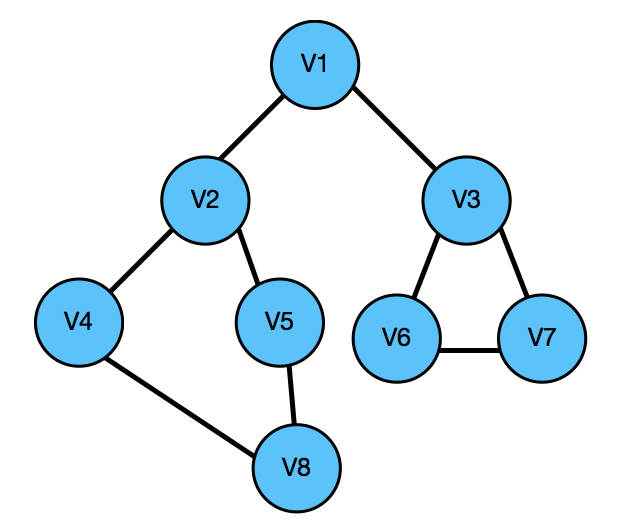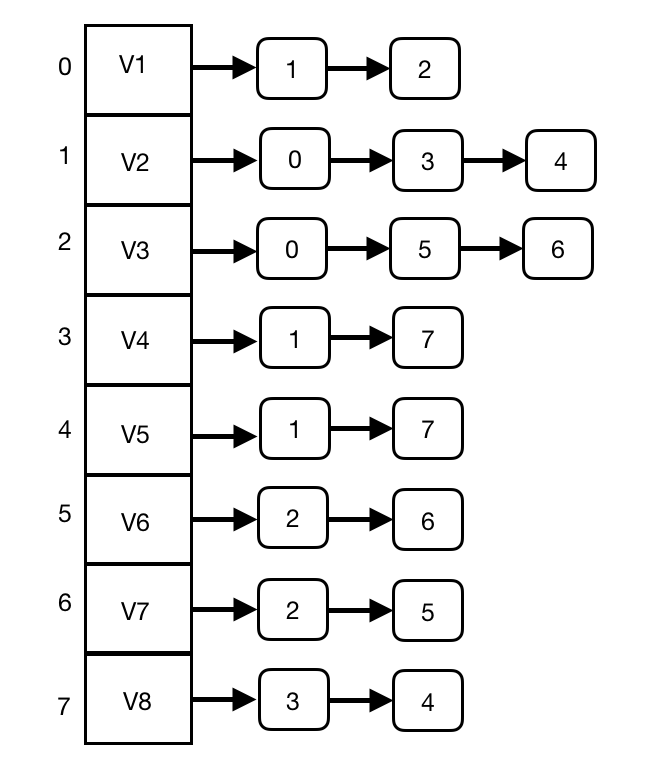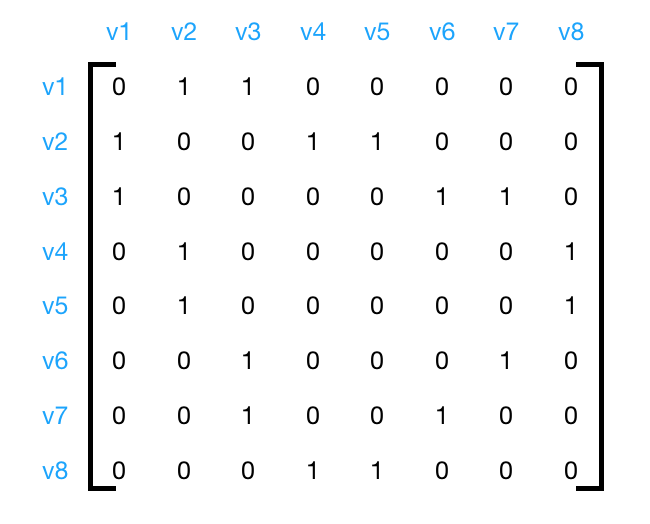一、基本思想
1)访问指定的起始顶点v;
2)依次从v的未被访问的邻接点出发,对图进行深度优先遍历;直至图中和v有路径相通的顶点都被访问;
3)若此时图中尚有顶点未被访问,则从一个未被访问的顶点出发,重新进行深度优先遍历,直到图中所有顶点均被访问过为止。
二、图的存储结构



示例图 图的邻接表存储方式 图的邻接矩阵存储方式
三、实现方式
1、邻接表
<?php
/**
* 图的深度优先遍历
* 图的存储结构--邻接表
*/
class Node{
public $value = null;
public $next = [];//存储下一个节点位置的数组
public function __construct($value = null){
$this->value = $value;
}
}
class Graph
{
// 记录节点是否已被遍历
public $visited = [];
// 图的邻接表数组
public $graph = [];
/**
* 为顶点添加邻接点
* @param $vertex 顶点v
* @param $adjvex 顶点v的邻接点
*/
public function addVertex($vertex, $adjvex)
{
$this->graph[$vertex][] = $adjvex;
}
// 将邻接表数组转为邻接链表
public function createGraph()
{
$vertices = array_keys($this->graph);
$result = [];
foreach ($vertices as $vertex) {
$result[$vertex] = new Node($vertex);
}
foreach ($this->graph as $vertex => $adjvex) {
foreach ($adjvex as $v) {
if (isset($result[$v]) && is_object($result[$v])) {
$result[$vertex]->next[] = $result[$v];
}
}
}
return $result;
}
/**
* 递归
* @param $v 传入的是第一个需要访问的顶点
*/
public function dfs($v) {
// 置已访问标记
$this->visited[$v] = 1;
// 输出被访问顶点
echo $v . PHP_EOL;
// print_r($this->graph[$v]);die;
for ($i = 0; $i < count($this->graph[$v]); $i++) {
if ($this->visited[$this->graph[$v][$i]] == 0) {
$this->dfs($this->graph[$v][$i]);
} else {
continue;
}
}
}
/**
* 非递归
* @param $v 传入的是第一个需要访问的顶点
*/
public function deepFirstSearch($v) {
// 初始化节点遍历标记
$vertices = array_keys($this->graph);
foreach ($vertices as $vertex) {
$this->visited[$vertex] = 0;
}
$stack[] = $v;
while (!empty($stack)) {
$current = array_pop($stack);
if ($this->visited[$current->value] == 0) {
echo $current->value . PHP_EOL;
$this->visited[$current->value] = 1;
}
for ($i = count($current->next) - 1; $i >= 0; $i--) {
if ($this->visited[$current->next[$i]->value] == 0) {
$stack[] = $current->next[$i];
}
}
}
}
}
// 测试
$vertices = ['v1', 'v2', 'v3', 'v4', 'v5', 'v6', 'v7', 'v8'];
$g = new Graph();
$g->addVertex('v1', 'v2');
$g->addVertex('v1', 'v3');
$g->addVertex('v2', 'v1');
$g->addVertex('v2', 'v4');
$g->addVertex('v2', 'v5');
$g->addVertex('v3', 'v1');
$g->addVertex('v3', 'v6');
$g->addVertex('v3', 'v7');
$g->addVertex('v4', 'v2');
$g->addVertex('v4', 'v8');
$g->addVertex('v5', 'v2');
$g->addVertex('v5', 'v8');
$g->addVertex('v6', 'v3');
$g->addVertex('v6', 'v7');
$g->addVertex('v7', 'v3');
$g->addVertex('v7', 'v6');
$g->addVertex('v8', 'v4');
$g->addVertex('v8', 'v5');
//print_r($g->graph);
// 递归
$g->dfs($vertices[0]);
// 非递归
$firstVertex = current($g->createGraph());
$g->deepFirstSearch($firstVertex);2、邻接矩阵
<?php
/**
* 图的深度优先遍历
* 图的存储结构--邻接矩阵
*/
class Graph {
// 存储节点信息
public $vertices;
// 存储边信息
public $arcs;
// 图的节点数
public $vexnum;
// 记录节点是否已被遍历
public $visited = [];
// 初始化
public function __construct($vertices) {
$this->vertices = $vertices;
$this->vexnum = count($this->vertices);
for ($i = 0; $i < $this->vexnum; $i++) {
for ($j = 0; $j < $this->vexnum; $j++) {
$this->arcs[$i][$j] = 0;
}
}
}
// 两个顶点间添加边(无向图)
public function addEdge($a, $b) {
if ($a == $b) { // 边的头尾不能为同一节点
return;
}
$this->arcs[$a][$b] = 1;
$this->arcs[$b][$a] = 1;
}
// 从第i个节点开始深度优先遍历
public function traverse($i) {
// 标记第i个节点已遍历
$this->visited[$i] = 1;
// 打印当前遍历的节点
echo $this->vertices[$i] . PHP_EOL;
// 遍历邻接矩阵中第i个节点的直接联通关系
for ($j = 0; $j < $this->vexnum ; $j++) {
// 目标节点与当前节点直接联通,并且该节点还没有被访问,递归
if ($this->arcs[$i][$j] == 1 && $this->visited[$j] == 0) {
$this->traverse($j);
}
}
}
// 递归
public function dfs() {
// 初始化节点遍历标记
for ($i = 0; $i < $this->vexnum; $i++) {
$this->visited[$i] = 0;
}
// 从没有被遍历的节点开始深度遍历
for ($i = 0; $i < $this->vexnum; $i++) {
if ($this->visited[$i] == 0) {
// 若是连通图,只会执行一次
$this->traverse($i);
}
}
}
// 非递归
public function deepFirstSearch() {
// 初始化节点遍历标记
for ($i = 0; $i < $this->vexnum; $i++) {
$this->visited[$i] = 0;
}
$stack = [];
for ($i = 0; $i < $this->vexnum; $i++) {
if (!$this->visited[$i]) {
$stack[] = $i;
while (!empty($stack)) {
// 出栈
$curr = array_pop($stack);
// 如果该节点还没有被遍历,则遍历该节点并将子节点入栈
if ($this->visited[$curr] == 0) {
echo $this->vertices[$curr] . PHP_EOL;
$this->visited[$curr] = 1;
// 没遍历的子节点入栈
for ($j = $this->vexnum - 1; $j >= 0; $j--) {
if ($this->arcs[$curr][$j] == 1 && $this->visited[$j] == 0) {
$stack[] = $j;
}
}
}
}
}
}
}
}
// 测试
$vertices = ['v1', 'v2', 'v3', 'v4', 'v5', 'v6', 'v7', 'v8'];
$graph = new Graph($vertices);
$graph->addEdge(0, 1); // v1 v2
$graph->addEdge(0, 2); // v1 v3
$graph->addEdge(1, 3); // v2 v4
$graph->addEdge(1, 4); // v2 v5
$graph->addEdge(2, 5); // v3 v6
$graph->addEdge(2, 6); // v3 v7
$graph->addEdge(4, 7); // v5 v8
$graph->addEdge(3, 7); // v4 v8
// 递归
$graph->dfs();
// 非递归
$graph->deepFirstSearch();来源:oschina
链接:https://my.oschina.net/u/4383141/blog/4285760